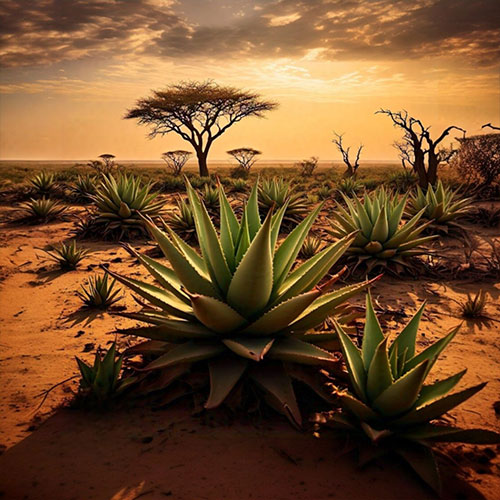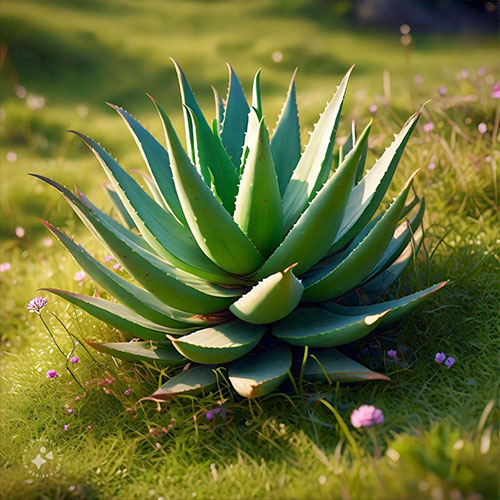






Aloe vera, a plant known for its heSaling and hydrating properties, has traveled far and wide across the globe. Its journey to Africa in the 19th century marked the beginning of a long-standing relationship with the continent, where it adapted beautifully to the diverse climates and became an integral part of local traditions. This blog explores how aloe vera became a cherished plant in Africa, from its introduction via European trade routes to its deep integration into African culture.
In the 19th century, European trade routes introduced aloe vera to Africa, where it quickly adapted to its new environment. Ships laden with crates labeled "Medicinal Plants" carried aloe vera across the Atlantic, and as they docked on the African coastline, the plant found a new home in Africa’s diverse climates.
Aloe vera’s resilience made it an ideal plant for Africa’s arid landscapes, where it thrived in the dry savannahs, deserts, and coastal regions. The plant’s ability to store water in its thick, fleshy leaves allowed it to withstand the harsh conditions, making it a valuable addition to the region.
Africa's varied climates present both challenges and opportunities for plant life, and aloe vera’s adaptability made it a perfect fit. The African savannahs and deserts, known for their dry, arid terrain, provided an ideal environment for aloe vera.
With its natural resilience, aloe vera flourished in these conditions, becoming an essential part of both rural and urban life. Its bright green leaves, which store moisture, became a symbol of survival and strength in regions where water was often scarce. The plant’s versatility allowed it to thrive where few others could, and it quickly became integrated into everyday practices.
In many African communities, aloe vera became a valuable resource for farmers. Its thick, gel-filled leaves were carefully harvested to preserve the precious gel inside. Farmers would use woven baskets to gather the leaves, often working under the shade of acacia trees to protect themselves from the harsh sun.
Aloe vera’s gel, which contains essential vitamins, minerals, and antioxidants, was prized for its healing properties. It was widely used in skincare, wound care, and various medicinal applications, making aloe vera a key part of agricultural practices in Africa. Its versatility ensured that it was utilized in many aspects of life, from daily wellness routines to more specific health treatments.
Aloe vera’s healing and soothing properties quickly made it a staple in African skincare routines. Local women, who often relied on natural remedies for maintaining healthy skin, began to incorporate aloe vera into their daily rituals.
In clay pots, aloe gel was blended with other natural oils and herbs, creating healing mixtures for dry skin, burns, and other skin conditions. For mothers, aloe vera became a go-to remedy for soothing children’s skin, particularly in the hot climates where sunburns and skin irritations were common. Aloe vera’s cooling effects made it a beloved plant in Africa’s skincare traditions, where it was valued for its ability to nourish and protect the skin.
Aloe vera’s integration into African culture extended beyond just skincare. It became a vital part of community healing ceremonies, used to treat burns, cuts, and skin irritations, while also being incorporated into various traditional rituals. Its versatility was a key reason for its widespread use: aloe vera was not only a practical remedy but also a symbol of health and well-being.
As demand for aloe vera grew, it was cultivated on larger scales. Aloe vera plantations began to emerge across the continent, with farmers recognizing the economic potential of this miraculous plant. Aloe vera’s legacy in Africa is now more than just a folk remedy—it has become an essential part of both traditional and modern wellness practices, contributing to the continent’s growing aloe vera industry.
Aloe vera’s journey to Africa represents more than just the introduction of a medicinal plant; it symbolizes resilience, adaptability, and the deep connection between nature and culture. From its arrival via European trade routes in the 19th century to its integration into African skincare and wellness rituals, aloe vera has become deeply rooted in African traditions.
Today, aloe vera continues to thrive in Africa’s diverse climates, playing a key role in both traditional medicine and modern wellness practices. The plant’s enduring legacy highlights the importance of nature’s gifts and the ways in which cultures around the world have embraced them for health and healing.
Coming Up Next: A New Home Down Under - Aloe Vera in Australia!
Join us as we journey to Australia, where aloe vera found a new home amidst the country’s unique landscapes. In this chapter, we’ll explore how this resilient plant adapted to the Australian environment and became a vital part of local skincare and wellness practices. Don’t miss the story of aloe vera’s exciting arrival and its growing importance in Australia!